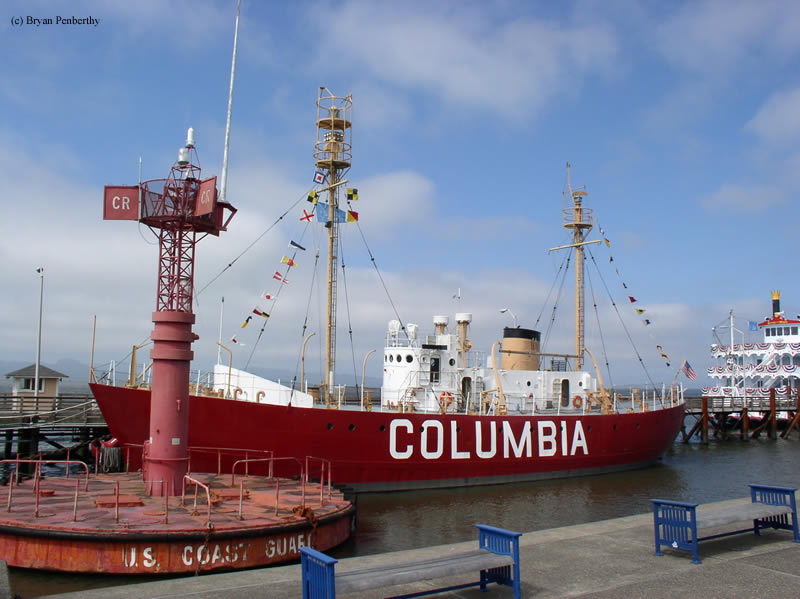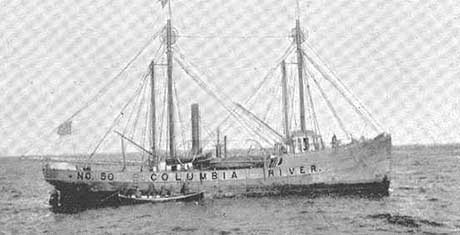Columbia Lightship (WLV-604)
Astoria, Oregon - 1951 (1951**)

History of the Columbia Lightship (WLV-604)
Posted/Updated by Bryan Penberthy on 2017-07-10.
When Light Vessel Number 50, also known as the Columbia River Lightship, was towed to its location five miles west of the mouth of the Columbia River in 1892, it became the first lightship to serve on the West Coast. WLV-604 was the final Columbia Lightship, serving from 1951 to 1979.
By the mid-1800s, the Columbia River had become a key transportation route, and steamships linked Portland with the many other communities, greatly simplifying trade. Although there were several ports in the Pacific Northwest, Portland had several advantages.
The first was its proximity to the Pacific Ocean. With it sitting at the confluence of the Willamette and Columbia Rivers, it had easy access to the ocean. The other advantage Portland had was easy access to the largely agricultural area of the Tualatin Valley and the lumber industry.
These advantages led to Portland's relatively quick growth. Between 1851 and 1890, the City of Portland had grown from 800 inhabitants to more than 46,000. This growth meant more ships began accessing the Columbia River. Because of this, the Lighthouse Board established the Cape Disappointment Lighthouse at the mouth of the Columbia River in 1856.
By the late 1880s, it was clear that the Cape Disappointment Lighthouse was inadequate to mark the mouth of the Columbia River and in 1888, the Lighthouse Board had begun making plans for a light vessel to sit about three miles outside the bar. The following appeared in the Annual Report of the Lighthouse Board for that year:
Columbia River Bar, light-ship, off the mouth of the Columbia River, Oregon - During the persistent summer fogs great difficulty is experienced by vessels approaching the coast near the bar, and they are often delayed outside and miss a tide, when there is a light fog or smoke. The Board therefore recommended that the proper steps be taken for the establishment of a light-ship fitted with a steam fog-whistle, about 3 miles outside the bar, which it is estimated will cost $60,000. A bill for that purpose is now pending before Congress.
On March 2, 1889, Congress approved the $60,000 for the Columbia River Lightship (LV-50), and by later that year, designs were in the drafting room at the General Lighthouse Depot on Staten Island. Along with the Columbia River Lightship, plans were being drawn up for lightships at Sandy Hook, Bush's Bluff, and Great Round Shoal as well as two steam tenders - one for the Great Lakes and the other for the second district.
After opening the bids for the construction of the lightship, the Lighthouse Board found that the cost of construction and outfitting exceeded the $60,000 appropriation and the Lighthouse Board put in a request for an additional $10,000.
 LV-50 circa 1906 (Courtesy Coast Guard)
LV-50 circa 1906 (Courtesy Coast Guard)
The Lighthouse Board signed a $60,150 contract with the Union Iron Works of San Francisco. Union Iron Works laid the keel on August 19, 1891, and completed the ship the following year on March 26, 1892, launching it into San Francisco Bay.
The Lighthouse Board then outfitted it with fuel, rations, and supplies from the Yerba Buena Lighthouse Depot. Although LV-50 had no propulsion system, it did have with sails. But to get the vessel from San Francisco to Astoria, it was towed by a lighthouse tender and arrived on April 5. On April 11, the lighthouse tender Manzanita towed LV-50 to her station three miles outside the Columbia River Bar, and it officially went into service on April 12, 1892.
Although the engineless LV-50 performed pretty well in the open Pacific Ocean during storms, that changed on November 28, 1899. Around 6:30 pm that night, during 74 mph winds her anchor chains parted. In an attempt to hold position, the crew was ordered to make sail. It didn't take long before the winds ripped the canvas to shreds leaving the ship to the mercy of the Pacific Ocean.
By morning, the lighthouse tender Manzanita and the tugs Wallula and Escort were rushing to the aid of LV-50. Although all three were able to get lines onto the distressed vessel, due to the strain, they all parted. By the early evening, LV-50 had run aground on a sandy beach near McKenzie Head, between North Head and Cape Disappointment.
Lifesaving crews were able to get the eight-man crew off the stricken vessel the following morning. In the interim, the Lighthouse Board marked the station with a first-class can buoy while recovery efforts were being carried out on LV-50.
Heavy storms during the month of December hampered recovery efforts of LV-50. As the ship held its own in the heavy surf, the tugs, Wallula and Escort returned in January to try and pull the beached vessel free.
When those operations failed, the Lighthouse Board called in Captain Robert McIntosh to salvage the ship on January 9. Although he made some progress, the Lighthouse Board canceled his contract in mid-June and sought new proposals. Most of the proposals were to pull the vessel back into the water, but three mentioned dragging the 250-ton vessel overland and relaunching it into the calmer waters of Baker Bay.
This time Wolff & Zwicker Iron Works of Portland were awarded the contract. They too attempted to refloat the vessel, but in the end, they were unable to free it.
Rather than giving up, Commander Day called for proposals one last time, this time specifying the overland route. After reviewing the proposals on January 19, 1901, the Portland-based firm of Andrew Allen and J. H. Roberts had the winning bid of $17,500. Surprisingly, they were a house-moving company.
Their contract stipulated that they would have the ship refloated in 35 days. Work began on February 22 and although they made considerable progress despite several weather-related setbacks, their 35 days were up, and they were facing a $100 a day penalty.
The Lighthouse Board had liked their progress and could see that the company would be successful given more time, and agreed to waive the penalties. On June 2, 1901, the house-moving firm from Portland had successfully launched LV-50 into Baker's Bay. After being repaired, LV-50 returned to its post marking the Columbia River Bar on August 15.
On June 30, 1906, the Lighthouse Board sought an appropriation of $50,000 for a new steel-hulled lightship with the contract not to exceed $130,000. Congress appropriated an additional $80,000 on March 4, 1907.
During that period, the Lighthouse Board had several vessels built on the East Coast for service on the Pacific Coast, which included three tenders and three light vessels. The light vessels included Columbia River (LV-88), Relief (LV-92), and Swiftsure Bank (LV-93).
When completed, the flotilla left the General Lighthouse Depot in Staten Island, New York on September 21, 1908, for the Pacific Coast by way of the Straights of Magellan. The group covered the 14,393 miles arriving in San Francisco on January 23, 1909.
That year, LV-88 assumed the position as the Columbia River Lightship and LV-50 returned to the district depot in Astoria. It stayed there until 1915 when the Lighthouse Service sold it at auction on April 27, 1915, for $1,667.99.
LV-88 continued its nightly display of an occulting white light every ten seconds through a 375mm lens. On April 13, 1911, the steamship Bear collided with the Columbia River light vessel, inflicting $600 of damage.
When the Coast Guard took control of the Lighthouse Service in 1939, they made several changes. They reassigned LV-88 to the Umatilla Reef in Washington, and LV-93 was assigned to mark the Columbia River Bar. LV-88 served the Umatilla Reef until 1959 and then as a Relief lightship until 1960.
In 1960, LV-88 was retired from duty and purchased for $20,000 from a Seattle ship breaking firm by the Columbia River Maritime Museum where it became a floating exhibit in 1963.
LV-93 served at the Columbia River until 1951 when the Coast Guard replaced it with WLV-604. At that time, LV-93 was decommissioned and later sold on November 2, 1955.
WLV-604 was built in 1950 by the Rice Brothers in East Boothbay, Maine at the cost of $500,000. The ship measured 128 feet in length, had a beam of 30 feet, an 11-foot draft, and was powered by an eight-cylinder Atlas-Imperial diesel engine providing 550 horsepower.
The vessel had an illuminating apparatus of Duplex 500mm electric lens lantern on the foremast, rated at 15,000 candlepower each visible for 15 miles and twin diaphone fog signals with a five-mile range.WLV-604 served the Columbia River until November 1979 when the Coast Guard replaced with an automated Lighted Navigational Horn Buoy (LNB) "CR." It was somewhat fitting that the Columbia River was both the first location and the last location for a lightship to serve on the West Coast.
The Columbia River Maritime Museum secured WLV-604 from the State of Oregon through the Federal Surplus Program on December 9, 1980. It replaced LV-88 as it was less expensive to maintain. At that time, the museum sold LV-88 to Pierre Pype who had plans to turn the vessel into a floating restaurant.
After the plans had fallen through, Pierre Pype sold LV-88 to Claude Lacerte in 1982. It was rebuilt into a half brigantine called the Belle Blonde and used as a sail-training vessel. It was eventually sold and delivered to Japan in 1988.
The LNB "CR" that took over for the Columbia River Lightship had a 40-foot diameter, was 42 feet in height, and cost $435,000. Atop the mast was a strobe light that was visible for 10 miles. The unit also contained a fog signal, radio signal, and radar reflection.
Due to the danger involved in servicing the LNB, the Coast Guard decommissioned it in 1993. It too was acquired by the Columbia River Maritime Museum and put on display next to WLV-604. The two appear in the picture above.
Today, the Columbia River Maritime Museum is open daily 9:30 am to 5:00 pm except for Thanksgiving Day and Christmas Day. As you tour the Columbia River Lightship, take the time to imagine what it would have been like riding out a storm in the Pacific Ocean.
Reference:
- Annual Report of the Light House Board, U.S. Lighthouse Service, Various years.
- U.S. Coast Guard website.
- Wikipedia website.
- Annual Report of the Secretary of Commerce, United States, Various.
- "Columbia River Light Ship No. 50," Jim Claflin, Lighthouse Digest, December 2004.
- Oregon's Seacoast Lighthouses, Jim Gibbs & Bert Webber, June 2003.
Directions: The lightship is located along Highway 30 in Astoria. At the point where Highway 101 heads north over the Columbia River, you want to follow Highway 30, which turns into Marine Drive.
Access: WLV-604 is owned by the Columbia River Maritime Museum. Grounds open, lightship open daily.
View more Columbia Lightship (WLV-604) picturesTower Height: 66.00'
Focal Plane: 67'
Active Aid to Navigation: Deactivated (1979)
*Latitude: 46.19040 N
*Longitude: -123.82390 W
See this lighthouse on Google Maps.
